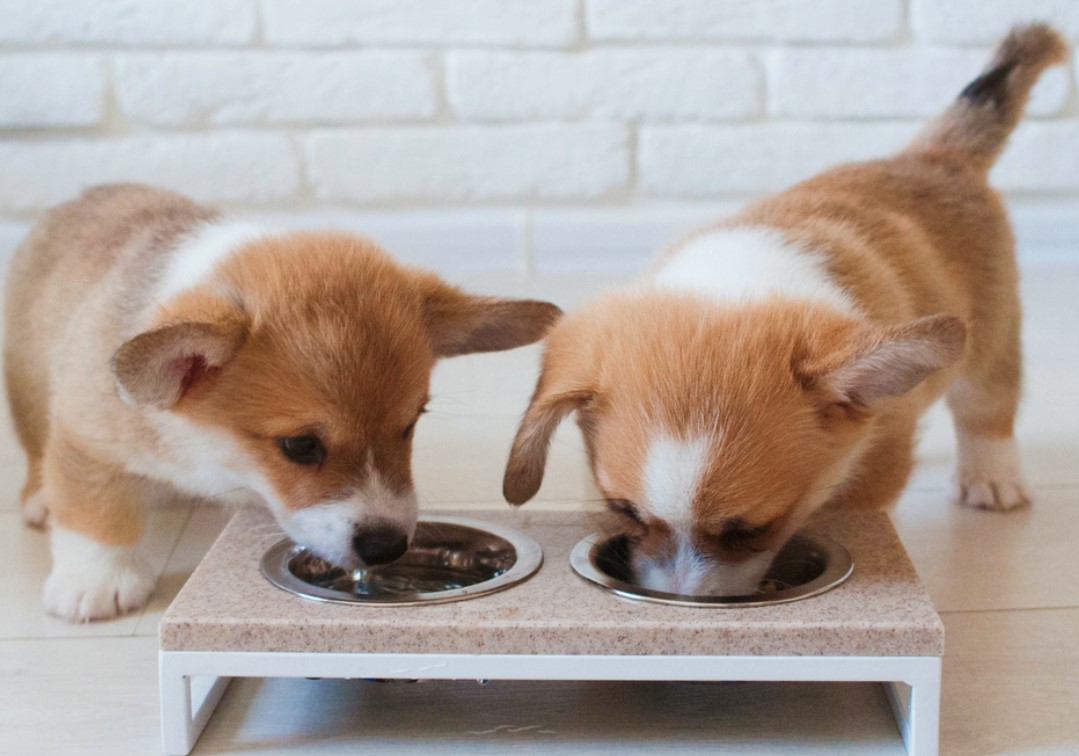So that a puppy can grow up healthy from the start, there are a few points to consider when feeding and choosing the food. Because puppies have different physical requirements and needs than adult dogs and therefore need special food.
You can read here how to feed your puppy correctly from the start and how to find the right puppy food.
Dog food for puppies – getting used to it

While puppies are still supplied with breast milk by their mother in the first few weeks of life, they need special puppy food after they are weaned.
To make it easy for puppies to adjust to the new food, start with wet puppy food that is similar to mashed food. You can also use dry food, but this should then be ground and mixed with three times the amount of lukewarm water to form a paste. Keep in mind that the puppy’s teeth are not yet fully formed and they still have milk teeth with sensitive teeth.
After an initial adjustment phase, puppies usually accept the food very well. Then the water supplied can be slowly reduced until the little ones eat the food undiluted.
Which puppy food is the best? You should take this into account when making your choice
When choosing the right food for puppies, it is essential that you feed them high-quality food. This will help you avoid digestive problems such as vomiting and diarrhea.
A good quality puppy food should meet the puppy’s energy and protein needs. Cereals should only be included in small amounts or preferably not at all. Potatoes, for example, are better and healthier than cereals as carbohydrate suppliers.
You can recognize a good dog food for puppies by the following criteria:
- The feed must be declared as a complete feed.
- It must be specifically labeled as puppy food.
- It should have a high meat content and preferably no animal meal. The meat content should also be broken down into muscle meat and offal.
- Artificial additives such as flavors, dyes, attractants, or preservatives should not be included.
- Sugar, also in the form of molasses, glucose, or fructose, is also taboo.
- The ingredients should all be as natural as possible.
- All ingredients should be food grade.
- The grain content should only be small. Vegetables are better than grains.
- Ideally, the meat used should come from animals from organic farms.
Optimal supply of necessary nutrients

For puppies, the right composition of the food plays an important role. In addition to nutrients such as protein, trace elements, and vitamins, an optimal supply of calcium and the right ratio between calcium and phosphorus is particularly important! Because these minerals are needed for healthy bone development and tooth growth. An ideal supply of calcium and phosphorus is essential, especially for larger dog breeds.
If the puppy’s need for energy and nutrients is not adequately met, deficiency symptoms and illnesses can occur. But even if the feed is too high in energy and the energy supply is too high, this can have consequences: This leads to rapid bone growth, which means that joint damage is inevitable, especially in large breeds.
And an oversupply of calcium and phosphorus during bone growth can also lead to problems, as the bones become brittle and can splinter.
If you are unsure about the choice of food or the right nutrient content, you should therefore consult your veterinarian or a nutritionist to be on the safe side.
How often should you feed puppies?

A puppy’s stomach cannot adequately digest large amounts of food in the first months of life. Therefore, especially small puppies aged eight to 16 weeks should not only be fed once or twice a day. Three or four smaller feed rations spread over the day are better.
If your puppy just doesn’t want to eat, that’s no problem, because not every young dog manages to eat regularly. Then just offer him a small portion again after a few hours.
As your young dog gets older, you can slowly change the feeding rhythm. For about five months, two meals a day are sufficient. You can then switch to one meal a day, but there are many dogs that do better with multiple rations than just one large portion once a day.
The Right Amount: How Much Should You Feed Puppies?
A mistake that unfortunately occurs again and again when feeding puppies is an oversupply or overfeeding. This can lead to obesity or serious skeletal disorders in adulthood.
Unfortunately, overfeeding in puppies is quite common, as you don’t tell your puppy that he’s getting too much food. Because in this case it will not increase visibly, but instead simply grow faster. The bones that are not yet fully grown and are still soft are put under too much strain, which means that healthy growth is no longer possible.
Therefore, make sure that you adjust the amount of food to the age and size and stick to the manufacturer’s recommended amount of food! It is best to weigh the food so as not to misjudge.
If you want to be on the safe side, a calorie requirement table for growing dogs or a calculated growth curve can help you. You can get these from your veterinarian or a nutritionist.
Attention: Additional treats such as chews and treats also have a lot of calories and must be taken into account! So, while it may be hard to resist those cute puppy eyes, remember that you’re not doing your pup any favors by giving them too many treats!
Important: Your dog needs a little more food in the cold winter months or when he is doing a little more physical exertion.
How Long Should You Feed Puppy Food?

You are probably wondering when you no longer need to feed puppies and when you can switch to adult food. There is no general answer to this because it depends entirely on your dog and the food used.
First of all, you should transition your puppy to suitable junior dog food before switching to adult dog food. There is adapted junior food for each month of the puppy’s life.
As a general rule, your puppy should be fed the junior food until it reaches what it should weigh as an adult dog.
This can be as early as around six months for small breeds, but it can take 15 to 20 months for large and giant breeds. If you are unsure about when you should change the food for your young dog, a nutritionist is a good contact here as well.
Large dog breeds in particular should not be fed puppies with high-energy food for long periods of time, as this promotes rapid growth, which can lead to diseases such as elbow and hip dysplasia.
With every change, it is important that you do not change the food abruptly from one day to the next, but proceed slowly and step by step. Because a sudden change in feed can lead to digestive problems.
It is best to plan at least five days for this and change the feed as follows: on the first day, you give 80% of the junior feed and 20% of the new feed. On the second day 60% of the previous food and 40% of the new food. On the third day, 40% of the previous food and 60% of the new food, etc. On the fifth day, your young dog then gets 100% of the new food.





























